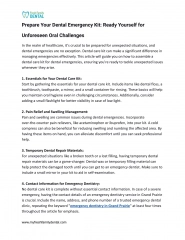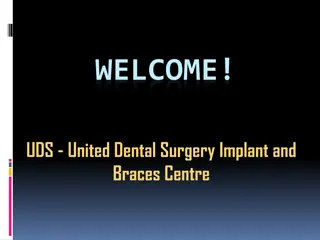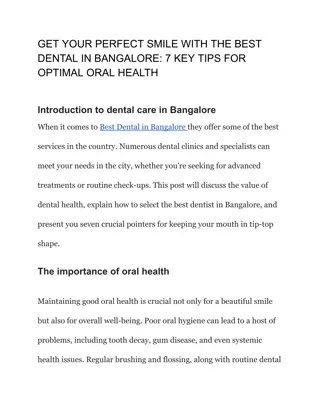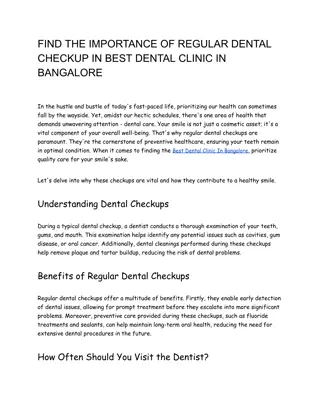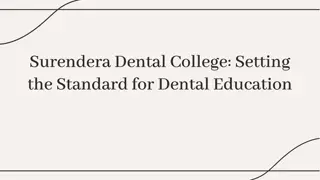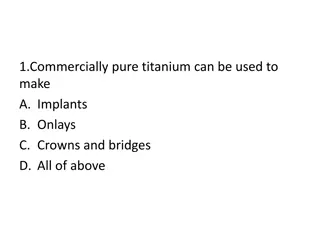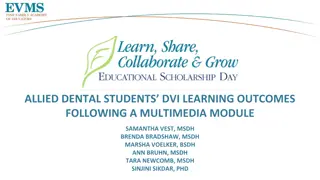Ectodermal Dysplasia: Causes, Effects, and Dental Care
Ectodermal dysplasia is a genetic condition affecting the development of teeth, skin, hair, and other structures derived from the ectoderm. This condition leads to abnormalities in various body parts, particularly the teeth. The dental team plays a crucial role in managing ectodermal dysplasia by recommending dentures or implants for functional and aesthetic purposes. Regular reconstruction of dentures is necessary due to ongoing jaw growth. This article explores the causes, effects, and dental care strategies for individuals with ectodermal dysplasia.
Uploaded on Apr 20, 2025 | 0 Views
Download Presentation

Please find below an Image/Link to download the presentation.
The content on the website is provided AS IS for your information and personal use only. It may not be sold, licensed, or shared on other websites without obtaining consent from the author.If you encounter any issues during the download, it is possible that the publisher has removed the file from their server.
You are allowed to download the files provided on this website for personal or commercial use, subject to the condition that they are used lawfully. All files are the property of their respective owners.
The content on the website is provided AS IS for your information and personal use only. It may not be sold, licensed, or shared on other websites without obtaining consent from the author.
E N D
Presentation Transcript
Outlines:- *Definition *warning signs of breast cancer *High risk group of breast cancer *The Five Steps of A Breast Self-Examination :
Definition: Breast self-examination (BSE) is a diagnostic technique regularly performed by a woman, independent from a physician, both by feeling for anything suspicious in her breasts and by observing any changes through the use of a mirror.
Appropriate time for performance of BSE. From 7-10 days from first day of menstruation. If woman no longer has a period, examine herself on the same day every month.
warning signs of breast cancer Skin changes, such as swelling, redness, or other visible differences in one or both breasts An increase in size or change in shape of the breast(s) Changes in the appearance of one or both nipples Nipple discharge other than breast milk General pain in/on any part of the breast Lumps or nodes felt on or inside of the breast
High risk group of breast cancer 1. Gender. Being a woman is the most significant risk factor for developing breast cancer. 2. Age simply growing older is the second biggest risk factor for breast cancer. 3. Family history of breast cancer 4. Personal history of breast cancer 5. Radiation therapy to the chest 6. Women who have never had a full-term pregnancy, or had their first full-term pregnancy after age 30, have an increased risk of breast cancer 7. Alcohol consumption 8. Smoking 9. Exposure to estrogen 10.Stress
The Five Steps of A Breast Self-Examination : Step 1: Begin by looking at your breasts in the mirror with your shoulders straight and your arms on your hips. Breast Self- Exam Step 1 Here's what you should look for: Breasts that are their usual size, shape, and color Breasts that are evenly shaped without visible distortion or swelling If you see any of the following changes, bring them to your doctor's attention: Dimpling, puckering, or bulging of the skin A nipple that has changed position or an inverted nipple (pushed inward instead of sticking out) Description: Breast Self-Exam - Step 1 Redness, soreness, rash, or swelling
Step 2: Now, raise your arms and look for the same changes. Breast Self-Exam Steps 2 and 3 Step 3: While you're at the mirror, look for any signs of fluid coming out of one or both nipples (this could be a watery, milky, or yellow fluid or blood). Description: Breast Self-Exam - Steps 2 and 3
Step 4: Next, feel your breasts while lying down, using your right hand to feel your left breast and then your left hand to feel your right breast. Use a firm, smooth touch with the first few finger pads of your hand, keeping the fingers flat and together. Use a circular motion, about the size of a quarter. Breast Self-Exam Step Description: Breast Self-Exam - Step 4 Cover the entire breast from top to bottom, side to side from your collarbone to the top of your abdomen, and from your armpit to your cleavage. Follow a pattern to be sure that you cover the whole breast. You can begin at the nipple, moving in larger and larger circles until you reach the outer edge of the breast. You can also move your fingers up and down vertically, in rows, as if you were mowing a lawn. This up-and-down approach seems to work best for most women. Be sure to feel all the tissue from the front to the back of your breasts: for the skin and tissue just beneath, use light pressure; use medium pressure for tissue in the middle of your breasts; use firm pressure for the deep tissue in the back. When you've reached the deep tissue, you should be able to feel down to your ribcage.
Description: Breast Self-Exam - Step 5 Step 5: Finally, feel your breasts while you are standing or sitting. Many women find that the easiest way to feel their breasts is when their skin is wet and slippery, so they like to do this step in the shower. Cover your entire breast, using the same hand movements described in step



